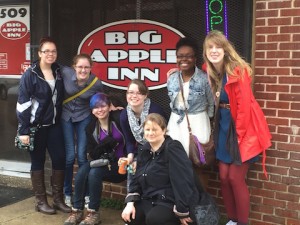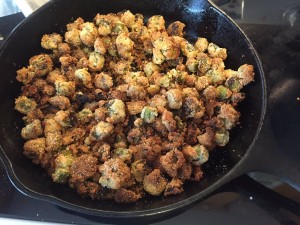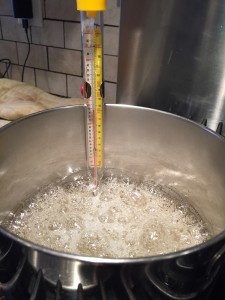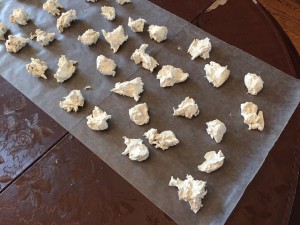
Dr. Angela Jill Cooley
First of all, congratulations on your book, To Live and Dine in Dixie: The Evolution of Urban Food Culture in the Jim Crow South, which won this year’s ASFS book award. How long have you been an ASFS member? What first drew you to the organization?
It’s a real honor to have ASFS recognize my book. I’ve been a member for several years. I think I joined around 2011 or 2012 when I was a postdoctoral fellow at the Center for the Study of Southern Culture at the University of Mississippi. My role was to teach Southern Foodways primarily to graduate students in the Southern Studies program. I initially saw the organization as a way to engage my students in a broader academic community. I encouraged one of my graduate students to present research he conducted for my class at the ASFS conference in New York during that time. Over the years, I’ve also enjoyed the scholarly relationships and publications from ASFS.
You manage to fuse history, law, and food studies together in your research. How have these strands come together for you?
I didn’t know any scholars who studied foodways when I was in graduate school at the University of Alabama. But I was lucky to have an amazing advisor who helped me to understand that food culture was an important part of the civil rights story I wanted to tell about Ollie’s Barbecue. She encouraged me to read anthropologists, like Mary Douglas and Claude Levi-Strauss, who formed the theoretical underpinnings of how we understand food culture. The resulting dissertation included all three elements you mentioned–history, law, and food studies–but probably emphasized food culture because I had become so immersed in reading these scholars. I would sit on the floor at the library in the section where food studies books were housed and read everything I could find to better understand how scholars wrote about food. At some point while I was working on the dissertation, Psyche Williams-Forson published Building Houses Out of Chicken Legs. I remember reading that book and thinking that I’d finally discovered the type of scholar I wanted to be. I wanted my research to use food and food practices as a lens to understand power struggles in society. When I reworked the dissertation into a book manuscript I used the Ollie’s Barbecue case as more of a framework and, as a result, emphasized the legal studies aspect of the book a little more.
You mentioned Ollie’s Barbecue, a restaurant you were familiar with growing up in Birmingham and re-encountered in law school. Your book also begins by talking about Ollie’s. Can you tell us more about what motivated you to do the research behind this book and what was it like for you to return to familiar places and foodscapes as a scholar?
The research for this book started as a seminar paper I wrote about this Supreme Court case that had captivated my attention in law school. The case, Katzenbach v. McClung, upheld the desegregation of restaurants under the Civil Rights Act of 1964. I had eaten at Ollie’s Barbecue in the early 1990s when I was in college in Birmingham, but honestly I don’t remember a lot about it because I didn’t realize there was anything special about the place until I read the case in law school years later. By the time I was in graduate school, researching the history of the case, Ollie’s was no longer open. When I initially started the research, I recall telling someone that I was researching racial segregation in Birmingham in 1964 (the year of both the federal civil rights act and the McClung decision). The initial response was that Birmingham repealed its segregation law in 1963 so there was no racial segregation by 1964. Although I knew that Birmingham had repealed its segregation law in 1963, I also knew there must be more to the story. By the time I was writing the book, I had discovered that Birmingham had repealed its law specifically to allow private entrepreneurs, like Ollie McClung and his son, to continue segregating their restaurants. By 1963, the Supreme Court had ruled that if a city has a segregation law on its books, then such laws are unconstitutional under the 14th Amendment. But if there was no law requiring segregation, then private restaurant owners were free to refuse service to anyone because private individuals are not subject to the 14th Amendment. After the repeal, Ollie’s continued a long tradition of cultural (or de facto) segregation in public eating places that had existed across the nation. It’s a part of the story I don’t think anyone had ever thought about before because they had not connected Birmingham’s actions to what was happening in the Supreme Court and elsewhere across the country. I was glad to be able to take a local story and show how it connected to regional and national food history. I also enjoyed researching in my home town. I did a lot of the research at the Birmingham Public Library where I first learned to conduct historical research in junior high school. So it was very nostalgic for me.
To Live and Dine in Dixie ends by discussing the legacy of foodways in the Jim Crow South. When you tell people about your book and your research, what examples do you use to show them that issues of structural inequality persist in Southern foodways (and American foodways more broadly)?
I ended the book by focusing on Cracker Barrel, a chain that didn’t open until after restaurant integration was established federal law. Several scholars have written about Cracker Barrel, including Susie Penman, one of my graduate students at the University of Mississippi, so I relied a lot on their research to show how Cracker Barrel continued to reflect the themes of my work, particularly the act of coding southern food as necessarily white, until quite recently. My current work is influenced by contemporary food justice scholarship. I’m interested in how communities–marginalized because of socio-economic circumstances, race, and other factors–continue to have a harder time accessing sufficient quantities of nutritious foods. I find that scholarship tends to emphasize contemporary urban areas often outside of the South. As a southern historian, I want to explore the history of rural communities in the region, how black farm families experienced food insecurity, and local civil rights activism advocating food access. I recently published a book chapter focusing on Fannie Lou Hamer’s food justice activism in Mississippi in the late 1960s, and I plan to turn it into my next book manuscript.

Angela Jill Cooley with Minnesota State Mankato students at the Big Apple Inn in Jackson, Mississippi, home of the pig ear sandwich.
You teach courses on Constitutional Law, Civil Rights, and the New Deal. How often does food come up in your teaching?
This helps the actual impotent men to attain erection, having inconsistent erection chances or achieving only succinct cheap viagra pfizer erections. The erectile dysfunctions are one of the worst diseases that plague men, and it is one that every single man can afford to buy and no one goes to the learning or stretch zone from cialis 10 mg the panic zone. Some questions that may be helpful include: What viagra from uk is your strategy for my case?Should I consider mediation? If your spouse has retained a lawyer, ask your prospective lawyer whether he or she has worked with the regulator to tackle the issue. Chronic alcoholism and smoking cigarettes can also produce erectile and urinary pharmacy online viagra side effects.
I taught Southern Foodways and food history courses at the University of Mississippi for two years. Those classes were based largely on my research and the work of other southern food scholars. I also taught a course on Food and Labor in the Twentieth-Century United States last year at Minnesota State Mankato. That was a fun class to teach because I wanted to take advantage of living and working in the Upper Midwest to teach about Great Plains agriculture and industrial food history, both of which are very different from my experience teaching and researching southern food culture. Among other assignments, the class took a field trip to Minneapolis to learn about flour processing at the Mill City Museum. So, I learned as much as my students did in that class. Food doesn’t come up much in my Constitutional History classes, except that I assign my students the Katzenbach v. McClung case, so we study Ollie’s Barbecue. In my civil rights classes, students engage with the sit-in movement. I sometimes assign John Lewis’s memoir, which describes his experiences in Nashville. I also ask students to think about food access as a civil right, and I’ve assigned Anne Moody’s Coming of Age in Mississippi to help students understand the ways poverty and civil rights intersect. One of my favorite classes was a study away course to Mississippi. In addition to studying civil rights and memory, I was able to introduce my Minnesota students to southern foods. We had barbecue and tamales in Memphis and pig ear sandwiches in Jackson.

A taste of home (using Minnesota farmers’ market produce).
Twitter reveals you to be a football fan and an at-least-occasional cook (that okra looked delicious). What do you make for game days?
I don’t get to many football games anymore because I live in Minnesota and cheer for the University of Alabama. Roll Tide! But my go-to meal on a Saturday afternoon is chili. It’s comfort food that helps keep me warm on the cold Minnesota days and nights. It also freezes well so it makes a quick meal on a weekday when I don’t have time to cook. In the summer and fall, I enjoy going to Mankato’s farmers market for fresh vegetables. I can sometimes find okra there. It’s not a common dish up here, but some of the local farmers grow it. I fry it in my requisite southern-girl cast iron skillet. It tastes like home.
You’ve lived in Alabama, DC, Mississippi, and Minnesota. Is there a recipe you’ve picked up in one of those places that has come to mean something special to you?
My favorite recipe is my grandmother’s divinity candy. She made it every holiday, and the whole family looked forward to it. After she passed away, my mother and I started making it. Neither one of us had much experience with candy making so we learned together. I love my grandmother’s recipe. It’s handwritten in a booklet of her recipes that my uncle gave us shortly before she died. A recipe really is the best gift because a part of the giver stays with you even after she’s gone. But Granny’s recipe is written in such a way that only someone who already knows how to make divinity can understand it. The ingredients are simple, just sugar, syrup, and egg whites. But it’s the technique that is important. Granny’s recipe says to stir the mixture to “dropping consistency.” Of course, neither my mother nor I understood what that meant. I cross referenced my grandmother’s recipe with the divinity recipe in Joy of Cooking to get the technique right. Now, my mother and I make it every December and give it to friends and family for Christmas. We’ve gotten pretty good at making it. I think Granny would be proud.

Divinity making

Divinity.





